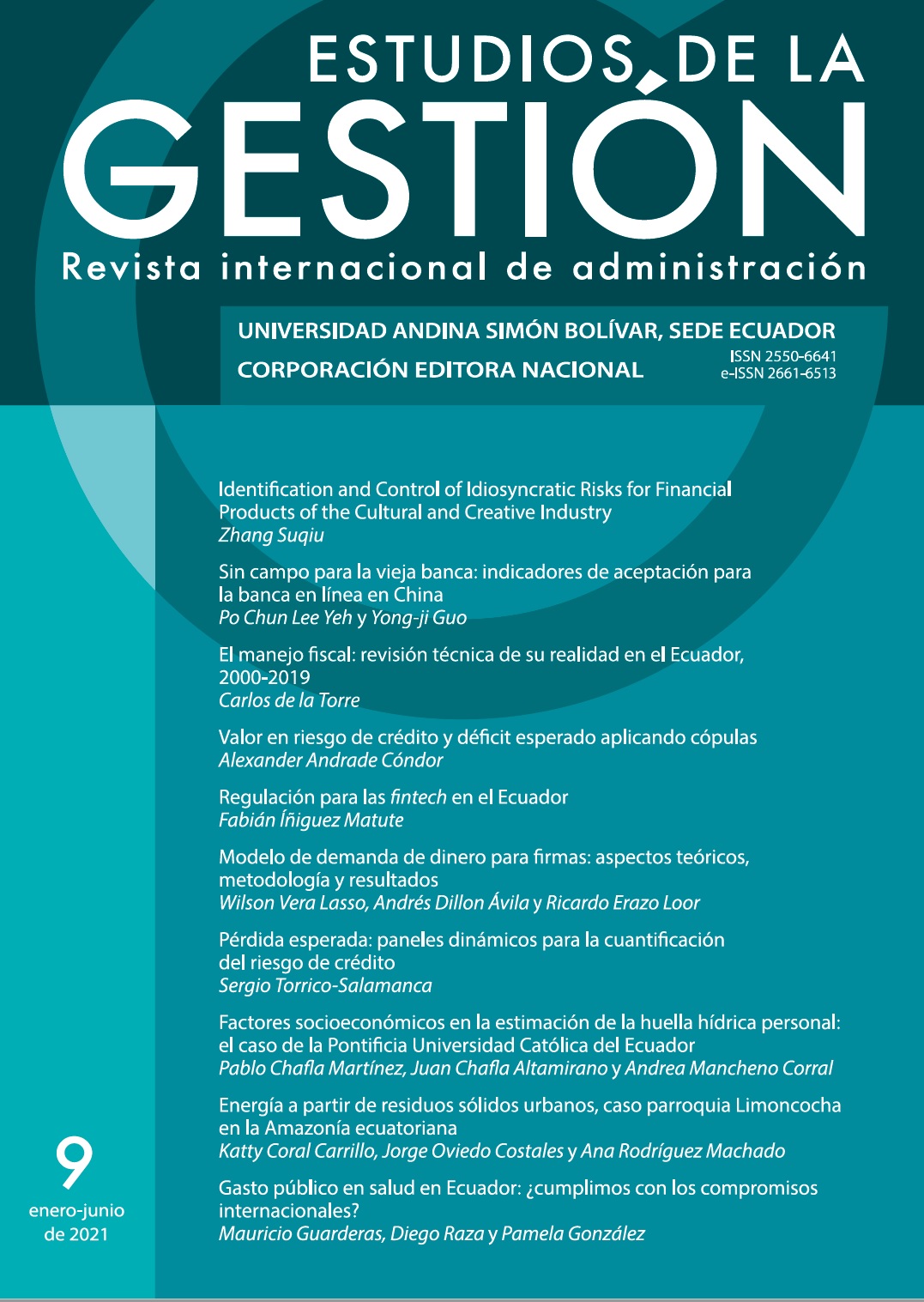Money Demand Model for Firms: Theoretical Aspects, Methodology and Results
DOI:
https://doi.org/10.32719/25506641.2021.9.6Keywords:
Money demand, treasury, business economics, investment policyAbstract
The purpose of this article is to contribute with the theoretical, methodological and empirical elements of the money demand for a company, so that the management of the treasury of firms and financial institutions using a significant flow of liquid monetary resources allows, on one hand, to minimize the opportunity costs of maintaining excess cash and, and on the other hand, to cover their short-term obligations in a timely manner. For this, in a medium-sized software marketing company, the application of the MOV model (Miller, Orr and Vera) of demand for money for firms is proposed, whose theoretical support is the initial approach of Miller and Orr, 1968, in addition to the contribution of Vera, 2004.
From the obtained results in this research, it is concluded that efficient liquidity management is possible minimizing transaction costs and maximizing the investment profitability in securities.
Downloads
References
Aznar, Antonio, y Eduardo Pozo. 1998. “Demanda de dinero y tipos de interés: un estudio teórico”. Revista Española de Economía 15 (1): 123-145. https://bit.ly/3bOb8un.
Baumol, William. 1952. “The Transactions Demand for Cash: An Inventory Theoretic pproach”. Quarterly Journal of Economics 66 (4): 545-556. doi:10.2307/1882104.
Feige, Edgar, y Michael Parkin. 1971. “The Optimal Quantity of Money, Bonds, Commodity Inventories and Capital”. America Economic Review 61 (3): 335-349. 10.2307/2553324.
Fisher, Irving. 1986. “Appreciation and Interest”. American Economic Association 3 (11): 331-442.
Goldman, Steven. 1974. “Flexibility and the Demand for Money”. Journal of Economic Theory 9 (2): 213-222. 10.1016/0022-0531(74)90067-2.
Guissarri, Adrián. 1986. La demanda de circulante y la informalidad en la Argentina, 1930-1983. Buenos Aires: Instituto Torcuato Di Tella.
Higson, Andrew, Shinozawad Yoshikatsu y Mark Tippett. 2010. “Organization Size and the Optimal Investmen in Cash”. Journal of Management Mathematics 21 (1): 27-38.
1093/imaman/dpp015.
Higuerey, Ángel. 2007. Administración del efectivo. Bogotá: Universidad de los Andes.
Jovanovic, Boyan. 1982. “Inflation and Welfare in the Steady State”. Journal of Political Economy 90 (3): 561-577. 10.1086/261074.
Keynes, John. 1936. The General Theory of Employment. Londres: McMillan.
Krajewski, Lee, Larry Ritzman y Manoj Malhotra. 2013. Administración de operaciones: procesos y cadena de suministro. Ciudad de México: Pearson Educación.
Mies, Verónica, y Raimundo Soto. 2000. “Demanda por dinero: teoría, evidencia, resultados”. Revista Economía Chilena 3 (3): 5-32. https://core.ac.uk/download/pdf/6642216.pdf.
Milbourne, Ross. 1983. “Optimal Money Holding Under Uncertainty”. International Economic Review 24 (3): 685-698. 10.2307/2648794.
Miller, Merton, y Daniel Orr D. 1968. “The Demand for Money by Firms: Extensions of Analytic Results”. Journal of Finance 23 (5): 735-759. 10.1111/j.1540-6261.1968.tb00314.x.
Pigou, Arthur. 1917. “The Value of Money”. The Quarterly Journal of Economics 32 (1): 38-65. 10.2307/1885078.
Ramos, Vicente. 2015. “La demanda de dinero”. En Introducción a la Macroeconomía, editado por Segundo Vicente Ramos, 24-54. Universidad del País Vasco/Euskal Herriko Unibertsitatea.
https://ocw.ehu.eus/course/view.php?id=342.
Reyes, Yolanda. 2012. “Modelo de Merton Miller y Daniel Orr”. Valparaíso: Pontificia Universidad Católica de Valparaíso. Serie de Apuntes Docentes. Accedido 15 de febrero.
Romer, David. 1987. “The Monetary Transmission Mechanism in a General Equilibrium Version of the Baul-Tobin Model”. Journal of Monetary Economics 20 (1): 105-122. 10.1016/0304-3932(87)90060-2.
Santomero, Anthony. 1974. “A Model of the Demand for Money by Households”. The Journal of Finance 29 (1): 89-102. 10.1111/j.1540-6261.1974.tb00026.x.
Tapiero, Charles, y Dror Zuckerman. 1980. “A Note on the Optimal Control of a Cash Balance Problem”. Journal of Banking and Finance 4 (4): 345-352. 10.1016/0378-4266(80)90013-8.
Tobin, James. 1956. “The Interest Elasticity of the Transactions Demand for Cash”. Review of Economics and Statistics 38 (3): 241-247. 10.2307/1925776.
Vera, Wilson. 2004. Reservas internacionales: nivel óptimo para el Ecuador. Quito: Escuela Politécnica Nacional.
---. 2017. Determinación de niveles óptimos de las reservas internacionales: una perspectiva teórica. Quito: Banco Central del Ecuador. Accedido 15 de febrero de 2020.
https://contenido.bce.fin.ec/documentos/PublicacionesNotas/Catalogo/NotasTecnicas/nota80.pdf.













